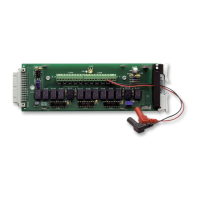Service Information
4-15
WARNING
Be sure to install and tighten the
grounding screw after replacing the
cover.
E. Remove the cover by pulling it off towards the rear.
4. Disconnect any wires connected to the scanner card ter-
minal blocks.
5. Install the scanner card in the multimeter.
6. Connect the line cord, and turn on the power to measure
voltages (see following paragraph).
4.7.3 Troubleshooting procedure
Table 4-3 summarizes scanner card troubleshooting steps.
Refer to the schematic diagram and component layout draw-
ings at the end of Section 5 for component locations.
WARNING
Lethal voltages are present within the
Model 2001. Some of the procedures
may expose you to hazardous voltages.
Observe standard safety precautions
for dealing with live circuits. Failure to
do so could result in personal injury or
death.
CAUTION
Observe the following precautions when
troubleshooting or repairing the scan-
ner card:
1. To avoid contamination, which could
degrade card performance, always
handle the card only by the side edg-
es and covers. Do not touch edge con-
nectors, board surfaces, or
components on the card. Also, do not
touch areas adjacent to electrical
contacts on connectors.
2. Use care when removing relays from
the PC board to avoid pulling traces
away from the circuit board. Before
attempting to remove a relay, use an
appropriate de-soldering tool, such
as a solder sucker, to clear each
mounting hole completely free of sol-
der. Each relay pin must be free to
move in its mounting hole before re-
moval. Also, make certain that no
burrs are present on the ends of the
relay pins.
3. If the bottom shield must be re-
placed, make sure that the overlay,
which contains warning messages, is
also replaced.
4. Removing the isothermal block will
damage the conductive RTV adhe-
sive. The RTV adhesive must be re-
placed if the isothermal block is
removed.
4.8 Scanner card modification
Channels 5 and 10 include 120Ω resistors in series with the
HI and LO terminals in order to avoid possible card damage
should the high-speed multiplexing, ratio, or delta modes be
inadvertently selected. (Damage may occur because break-
before-make operation for channels 5 and 10 cannot be guar-
anteed when the high-speed scanning modes of the Model
2001 Multimeter are selected). These resistors can be re-
moved and replaced with jumper wires in cases where the
nominal 240Ω path resistance may affect signals switched
through channels 5 and 10.
CAUTION
Use extreme care after replacing cur-
rent-limiting resistors with jumper
wires. External sources connected to
channels 5 and 10 should be current-
limiting to a maximum current of 1A,
and the ratio, delta, and high-speed
multiplexing modes of the Model 2001
Multimeter should not be used with the
Model 2001-TCSCAN.
Figure 4-10 shows the location of the factory-installed cur-
rent-limiting resistors. R152 and R153 provide current limit-
ing for channel 5, while R154 and R155 perform the same
function for channel 10. To make the modification, simply

